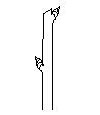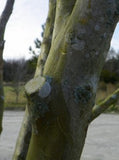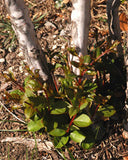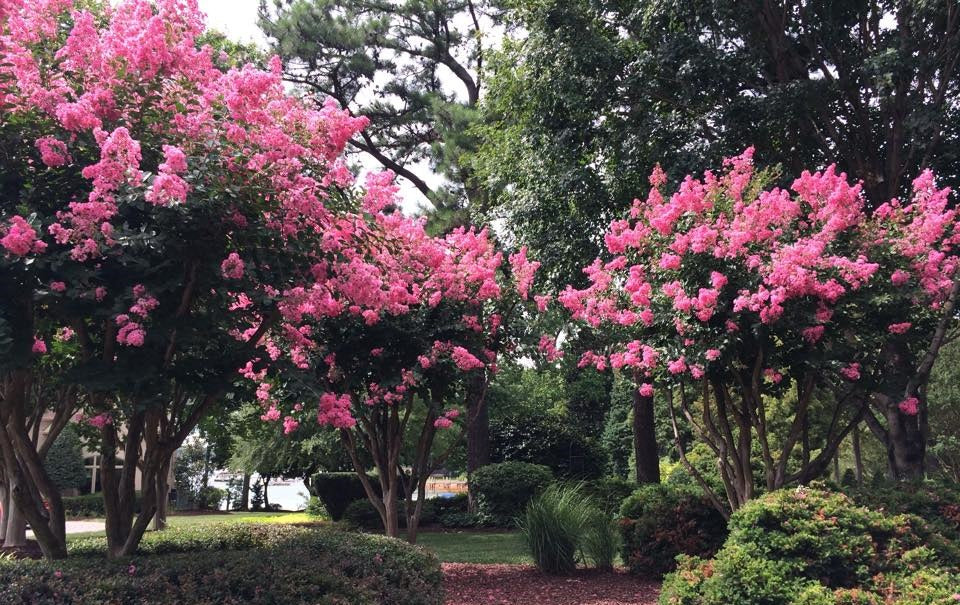Crape myrtle pruning skills are a must because Crape Murder sounds terrible, doesn’t it? There is a reason this morbid name was awarded to this severe type of pruning crape myrtle trees. The treatment for crape murder or topping is pruning your entire tree down to 1 or 2 inches from the ground!! After you watch a tree grow with anticipation for years chopping it off to the ground is pretty heartbreaking. We don’t want to see you crying over the loss of your beautiful tree. We love them too. Read on and learn how to hone you crape myrtle pruning skills.
Crape Murder aka Topping: Why is it Such a Big Deal?
 Topping may be an easier form of pruning especially when you want to control size, but it makes your tree weaker. By removing most of the branches and cutting your tree back to the trunks you can actually promote several issues that result in an unhealthy and less attractive tree. It can result in delayed flowering, less blooms, shorter bloom time, thin, weak branches that droop and even break during flowering, and an increase in the risk of pest and disease problems. You will also likely lose that lovely colorful, peeling bark that is a hallmark of mature trees. Topping also leaves large wounds and scars that become permanent knobby lumps. Will crape murder kill your tree? Probably not; crapes are pretty darn resilient. But as you can see it definitely isn’t good for you tree and can even be harmful enough to lead to death or just to a very sick tree.
Topping may be an easier form of pruning especially when you want to control size, but it makes your tree weaker. By removing most of the branches and cutting your tree back to the trunks you can actually promote several issues that result in an unhealthy and less attractive tree. It can result in delayed flowering, less blooms, shorter bloom time, thin, weak branches that droop and even break during flowering, and an increase in the risk of pest and disease problems. You will also likely lose that lovely colorful, peeling bark that is a hallmark of mature trees. Topping also leaves large wounds and scars that become permanent knobby lumps. Will crape murder kill your tree? Probably not; crapes are pretty darn resilient. But as you can see it definitely isn’t good for you tree and can even be harmful enough to lead to death or just to a very sick tree.
Let’s start with the number one way to avoid the pervasive gardening sin, Crape Murder!
Choose the Right Crape Myrtle for Your Space

Don’t just buy a generic crape myrtle you know nothing about. Do some research and choose the best variety by mature height and width for your space. This single part of the planning process will make your life much easier and keep your tree healthier and happier. There are so many stunning options now in dwarf and small crape myrtles like the First Editions Magic and Black Diamond series. The Pink Velour and Catawba are traditional crape myrtles that stay under 15 feet. Just a little bit of research and you will definitely find the right fit!
Crape Myrtle Pruning the Right Way
Do I need to prune crape myrtles?
If your tree is healthy and you like its form there is absolutely no requirement to prune it! Pruning crape myrtle trees unnecessarily will not offer any advantage to your tree.
When should I prune crape myrtles?
The best time of year to prune crape myrtles is in late winter right before they come out of dormancy. However, in the case of diseased branches, remove these right away.
What is your goal in pruning crape myrtle trees?
Your goal should be enhancing your trees natural shape. When you have that goal in mind when pruning it helps you to make the right cuts and snips.
Why Should I Prune my Crape Myrtle?
Preserving the natural shape
What is the natural shape of a crape myrtle? These trees are generally multi trunk trees that grow upright or in a vase shape. The trunks grow upward and slightly outward as do the branches. So when pruning crape myrtle trees work with this natural habit by removing branches that grow in toward the tree or down toward the ground. This opens your tree up and offers better air flow and sun penetration providing you with a healthier tree.
Removing dead or dying branches
This is important to keep your tree looking good and staying healthy. Dead and diseased wood can invite pests to invade that sick area which can spread to healthy portions of the tree. This is a case where you want to prune as soon as possible.
Winter tip dieback
This is common when dealing with cold winters especially for our customers on the edge of the recommended growing zones. Don’t panic! Tip dieback is not your tree dying. Think of it as frostbite of your tree. Once extreme temperatures have passed just trim back to the healthy portion of the branch.
Controlling size
Well your tree is a little bigger than expected. What do you do? Prune a little yearly. Do not skip a year and end up in a dire situation where you need to prune back too much. Look at the branches and observe the size; do not remove more than 1/3 of the length of each branch as a rule.
Pruning Crape Myrtle Trees: How do I do it Right?
Pruning Small Branches
 Trim small branches right at the juncture where they meet the lateral branch or the trunk. If you do not want to remove the entire branch prune back to a bud that is facing outward from the tree. Prune to about ¼ inch above the bud on an angle that is also facing outward and upward from the tree. You can use basic pruners for small branches.
Trim small branches right at the juncture where they meet the lateral branch or the trunk. If you do not want to remove the entire branch prune back to a bud that is facing outward from the tree. Prune to about ¼ inch above the bud on an angle that is also facing outward and upward from the tree. You can use basic pruners for small branches.
Pruning Large Branches
 To prune off a large branch, follow the branch back to the branch or trunk where it meets. At the juncture you will notice a swelling. This is a branch collar. Cut just above the branch collar, not flush with trunk. Use loppers or a pruning saw for larger branches. The remaining branch collar will generally extend less than an inch from the trunk. Leaving the branch collar will generally prevent regrowth from the cut.
To prune off a large branch, follow the branch back to the branch or trunk where it meets. At the juncture you will notice a swelling. This is a branch collar. Cut just above the branch collar, not flush with trunk. Use loppers or a pruning saw for larger branches. The remaining branch collar will generally extend less than an inch from the trunk. Leaving the branch collar will generally prevent regrowth from the cut.
Pruning Trunks
Avoid pruning whole trunks if at all possible. However if needed cut off the trunk as close the ground as possible. Trunk pruning crape myrtle trees often results in suckers and usually several of them emerging from the cut in summer. They are ugly, fast growing, and a pain in the tush to stay on top of so only prune trunks as a last resort.
Pruning Suckers
 The best way to remove suckers is by grabbing firmly and twisting and pulling straight from the ground. Alternatively when you have suckers coming from the ground that are too difficult or ones that are coming from the trunk, cut them as close to the ground or the trunk as possible.
The best way to remove suckers is by grabbing firmly and twisting and pulling straight from the ground. Alternatively when you have suckers coming from the ground that are too difficult or ones that are coming from the trunk, cut them as close to the ground or the trunk as possible.
So, don’t turn you beautiful crape myrtles into ugly lumpy stumps! These flowering trees often don't even need to be pruned. So prune responsibly and only as needed!

Now that you know all about pruning crape myrtle trees, be sure to browse our Crape Myrtle tree collection for additional options!


 Topping may be an easier form of pruning especially when you want to control size, but it makes your tree weaker. By removing most of the branches and cutting your tree back to the trunks you can actually promote several issues that result in an unhealthy and less attractive tree. It can result in delayed flowering, less blooms, shorter bloom time, thin, weak branches that droop and even break during flowering, and an increase in the risk of pest and disease problems. You will also likely lose that lovely colorful, peeling bark that is a hallmark of mature trees. Topping also leaves large wounds and scars that become permanent knobby lumps. Will crape murder kill your tree? Probably not; crapes are pretty darn resilient. But as you can see it definitely isn’t good for you tree and can even be harmful enough to lead to death or just to a very sick tree.
Topping may be an easier form of pruning especially when you want to control size, but it makes your tree weaker. By removing most of the branches and cutting your tree back to the trunks you can actually promote several issues that result in an unhealthy and less attractive tree. It can result in delayed flowering, less blooms, shorter bloom time, thin, weak branches that droop and even break during flowering, and an increase in the risk of pest and disease problems. You will also likely lose that lovely colorful, peeling bark that is a hallmark of mature trees. Topping also leaves large wounds and scars that become permanent knobby lumps. Will crape murder kill your tree? Probably not; crapes are pretty darn resilient. But as you can see it definitely isn’t good for you tree and can even be harmful enough to lead to death or just to a very sick tree.
 Trim small branches right at the juncture where they meet the lateral branch or the trunk. If you do not want to remove the entire branch prune back to a bud that is facing outward from the tree. Prune to about ¼ inch above the bud on an angle that is also facing outward and upward from the tree. You can use basic pruners for small branches.
Trim small branches right at the juncture where they meet the lateral branch or the trunk. If you do not want to remove the entire branch prune back to a bud that is facing outward from the tree. Prune to about ¼ inch above the bud on an angle that is also facing outward and upward from the tree. You can use basic pruners for small branches. To prune off a large branch, follow the branch back to the branch or trunk where it meets. At the juncture you will notice a swelling. This is a branch collar. Cut just above the branch collar, not flush with trunk. Use loppers or a pruning saw for larger branches. The remaining branch collar will generally extend less than an inch from the trunk. Leaving the branch collar will generally prevent regrowth from the cut.
To prune off a large branch, follow the branch back to the branch or trunk where it meets. At the juncture you will notice a swelling. This is a branch collar. Cut just above the branch collar, not flush with trunk. Use loppers or a pruning saw for larger branches. The remaining branch collar will generally extend less than an inch from the trunk. Leaving the branch collar will generally prevent regrowth from the cut. The best way to remove suckers is by grabbing firmly and twisting and pulling straight from the ground. Alternatively when you have suckers coming from the ground that are too difficult or ones that are coming from the trunk, cut them as close to the ground or the trunk as possible.
The best way to remove suckers is by grabbing firmly and twisting and pulling straight from the ground. Alternatively when you have suckers coming from the ground that are too difficult or ones that are coming from the trunk, cut them as close to the ground or the trunk as possible. 